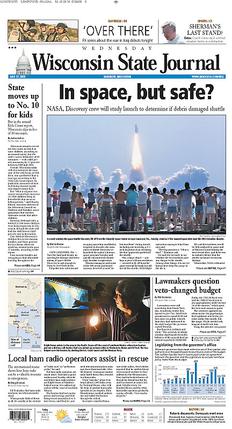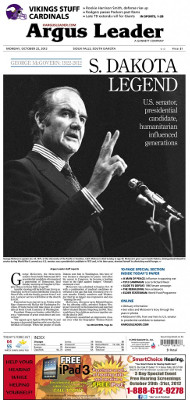Related Research Articles
Desktop publishing (DTP) is the creation of documents using dedicated software on a personal ("desktop") computer. It was first used almost exclusively for print publications, but now it also assists in the creation of various forms of online content. Desktop publishing software can generate page layouts and produce text and image content comparable to the simpler forms of traditional typography and printing. This technology allows individuals, businesses, and other organizations to self-publish a wide variety of content, from menus to magazines to books, without the expense of commercial printing.
The Mergenthaler Linotype Company is a corporation founded in the United States in 1886 to market the Linotype machine, a system to cast metal type in lines (linecaster) invented by Ottmar Mergenthaler. It became the world's leading manufacturer of book and newspaper typesetting equipment; outside North America, its only serious challenger for book typesetting was the Anglo-American Monotype Corporation.

Typesetting is the composition of text for publication, display, or distribution by means of arranging physical type in mechanical systems or glyphs in digital systems representing characters. Stored types are retrieved and ordered according to a language's orthography for visual display. Typesetting requires one or more fonts. One significant effect of typesetting was that authorship of works could be spotted more easily, making it difficult for copiers who have not gained permission.

The Evening and the Morning Star was an early Latter Day Saint movement newspaper published monthly in Independence, Missouri, from June 1832 to July 1833, and then in Kirtland, Ohio, from December 1833 to September 1834. Reprints of edited versions of the original issues were also published in Kirtland under the title Evening and Morning Star.

Letterpress printing is a technique of relief printing for producing many copies by repeated direct impression of an inked, raised surface against individual sheets of paper or a continuous roll of paper. A worker composes and locks movable type into the "bed" or "chase" of a press, inks it, and presses paper against it to transfer the ink from the type, which creates an impression on the paper.
Today was a national newspaper in the United Kingdom that was published between 1986 and 1995.

Phototypesetting is a method of setting type which uses photography to make columns of type on a scroll of photographic paper. It has been made obsolete by the popularity of the personal computer and desktop publishing which gave rise to digital typesetting.

Monotype Imaging Holdings Inc., founded as Lanston Monotype Machine Company in 1887 in Philadelphia by Tolbert Lanston, is an American company that specializes in digital typesetting and typeface design for use with consumer electronics devices. Incorporated in Delaware and headquartered in Woburn, Massachusetts, the company has been responsible for many developments in printing technology—in particular the Monotype machine, which was a fully mechanical hotmetal typesetter, that produced texts automatically, all single type. Monotype was involved in the design and production of many typefaces in the 20th century. Monotype developed many of the most widely used typeface designs, including Times New Roman, Gill Sans, Arial, Bembo and Albertus.

The Dong-a Ilbo is a daily Korean-language newspaper published in South Korea. It is considered a newspaper of record in the country, and was founded in 1920. The paper has been a significant presence in Korean society and history, especially during the 1910–1945 Japanese colonial period, when it championed the Korean independence movement.

The Museum of Printing (MoP), located in Haverhill, Massachusetts, is a museum dedicated to preserving the history of printing technologies and practices, the graphic arts, and their role in the development of culture and literacy.

The Wisconsin State Journal is a daily newspaper published in Madison, Wisconsin by Lee Enterprises. The newspaper, the second largest in Wisconsin, is primarily distributed in a 19 county region in south-central Wisconsin. As of September 2018, the Wisconsin State Journal had an average weekday circulation of 51,303 and an average Sunday circulation of 64,820. The State Journal is the state's official newspaper of record, and statutes and laws passed are regarded as official seven days after the publication of a state legal notice.

The Argus Leader is the daily newspaper of Sioux Falls, South Dakota. It is the largest newspaper by total circulation in South Dakota.
The Times and Democrat is a daily newspaper in Orangeburg, South Carolina. The Times and Democrat is owned by Lee Enterprises, a company based in Davenport, Iowa.
Kane County Chronicle is a weekly newspaper, published in St. Charles, Illinois, serving Kane County.

The Qapqal News is the world's only newspaper in the Xibe language, a Tungusic language spoken in Northwest China. It is one of roughly fifty minority-language newspapers in the Xinjiang autonomous region of China.
The Neligh News and Leader, owned by Pitzer Digital LLC, is a weekly newspaper published in Neligh, Nebraska, serving as the county-seat newspaper for Antelope County, Nebraska. The News & Leader was established in 1879.

The Cooper Review is an American weekly newspaper published in Cooper, Texas. It was founded around 1880 by the Hornebeck family as The Cooper Banner; however, through mergers, its history dates to 1873, when The Delta Courier was established. As one of the original businesses in its county that still operates, the paper currently serves the city of Cooper, as well as most of Delta County, and the surrounding areas. The newspaper was recently owned and published by the Butler family of Cooper, Jim and Sally Butler, and edited by Janis Thomas and Cindy Roller. Before the passing of Owner Jim Butler on Saturday, March 6, 2021, the Cooper Review transferred ownership to the Harmon family, originally of Cooper, Karrie Harmon and daughter, Rhandi Allred. The family owned, operated and published the Cooper Review until March 6, 2023, when it was sold to its current Owner and Publisher Ashley Colvin, also of Cooper. Since 2011, it has been a member of the Texas Press Association. The most recent archives of the Cooper Review may be found at the Texas Press Association's website at http://archive.texaspress.com/. The Cooper Review also posts all public notices, as of November 30, 2023, on the Texas Press Association's public notice website at https://www.texaspublicnotices.com/(S )/default.aspx. For its older archive, you can visit https://texashistory.unt.edu/ to view publications as far back as 1904.
The Ashland Gazette is a weekly newspaper serving Ashland, Nebraska and surrounding communities of Saunders County, Nebraska.
Cedar County News is a weekly newspaper serving Hartington, Nebraska and surrounding communities of Cedar County, Nebraska. It is published on Wednesdays and has an estimated circulation of 1,483.
The Gretna Breeze is a newspaper serving Gretna, Nebraska and surrounding communities. The paper is part of Suburban Newspapers Inc., which is a subsidiary of Omaha World-Herald, which is owned by Lee Enterprises.
References
- ↑ "Nebraska Newspaper Locator Map | Nebraska Press Association". 2012-11-21. Retrieved 2023-04-10.
- ↑ "Elgin Review newspaper - MondoTimes.com". www.mondotimes.com. Retrieved 2019-02-14.
- ↑ Co, Pettingill & (1899). National Newspaper Directory and Gazetteer. Pettingill & Company.
- ↑ National Endowment for the Humanities. "The Elgin review. [microfilm reel]" . Retrieved 2019-02-14.
- ↑ "McCord sells to Scofield". The Nebraska State Journal. 1897-05-15. p. 4. Retrieved 2019-02-14.
- 1 2 3 4 5 6 "Elgin, Nebraska Centennial (1889-1989)" Published by James E. and Julianne K. Dickerson
- ↑ "Butler's campaign headed by Peterson". Lincoln Journal Star. 1939-07-31. p. 2. Retrieved 2019-02-15.
- ↑ "Lt. Col. Val Peterson". Sioux City Journal. 1945-12-05. p. 10. Retrieved 2019-02-15.
- ↑ Capace, Nancy (1999). Encyclopedia of Nebraska. Somerset Publishers, Inc. ISBN 9780403098347.
- ↑ "NPA Past Presidents | Nebraska Press Association" . Retrieved 2019-02-14.
- ↑ Morgan, Lynell (2018-05-02). "Elgin Review receives 10 awards in NPA Better Newspaper Contest". The Elgin Review Online Edition. Retrieved 2019-02-15.
- ↑ Morgan, Lynell (2017-05-04). "Newspaper Earns 11 Awards From NPA "Better Newspaper Contest"". The Elgin Review Online Edition. Retrieved 2019-02-15.
- ↑ Morgan, Lynell (2016-04-28). "Newspaper Garners Four First Place Awards, Six Total In NPA Better Newspaper Contest". The Elgin Review Online Edition. Retrieved 2019-02-15.
- ↑ Morgan, Lynell (2015-04-26). "Morgan Elected NPA President; Newspaper Earns Four Awards At Convention". The Elgin Review Online Edition. Retrieved 2019-02-15.
- ↑ Morgan, Lynell (2014-04-17). "Elgin Review Claims Two First Place Awards in NPA 'Better Newspaper Contest'". The Elgin Review Online Edition. Retrieved 2019-02-15.